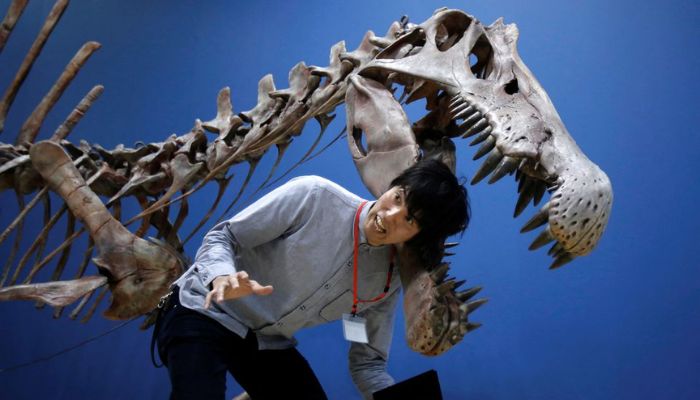Study shows eye sockets gave T. rex and friends more bite force
T. rex possessed awe-inspiring bite force to pack about 8,000 pounds (3,630 kg) of might, about equal to the weight of three small cars
August 12, 2022

- T. rex possessed awe-inspiring bite force to pack about 3,630 kg of might.
- Scientist examined eye socket shape in 410 extinct species, 230 dinosaurs.
- Once theropod species attained skull length of about three feet, shape of its eye sockets had become keyhole-shaped.
WASHINGTON: Tyrannosaurus rex possessed awe-inspiring bite force, with the huge meat-eating dinosaur's bone-crunching chomp estimated to pack about 8,000 pounds (3,630 kg) of might — about equal to the weight of three small cars.
This bite strength was aided in T. rex and other large predatory dinosaurs by an intriguing evolutionary modification in the skull, with the eye socket — called the orbital bone — becoming elliptical or keyhole-shaped rather than circular, according to a study published on Thursday.
The study used computer simulations to show that a skull with a circular eye socket was more vulnerable to high stresses during biting, but the modified shapes seen in large meat-eating dinosaurs greatly reduced these stresses and facilitated strong bite forces without compromising skull integrity.
"High bite forces and loads during feeding need to be accommodated by the skull and lower jaw," said paleontologist Stephan Lautenschlager of the University of Birmingham in England, author of the research published in the journal Communications Biology.
"This can be achieved by having a stronger skull — more bone — or channeling the occurring stress and deformation in such a way that the loads are reduced. This is achieved by the non-circular orbits," Lautenschlager added.
Lautenschlager examined eye socket shape in 410 extinct species including 230 dinosaurs as well as some of their reptilian cousins such as the crocodile lineage and the flying reptiles called pterosaurs. Of particular interest was a group called theropods, bipedal creatures that included all of the meat-eating dinosaurs.
It turned out that once a theropod species attained a skull length of about three feet (one meter) or more, the shape of its eye sockets had become elliptical or keyhole-shaped.
This evolutionary change occurred independently in a variety of theropod groups globally over time, the study showed.
These included tyrannosaurs including North America's T. rex and Asia's Tarbosaurus, carcharodontosaurs including South America's Giganotosaurus and Africa's Carcharodontosaurus, abelisaurs including South America's Carnotaurus, allosaurs including North America's Allosaurus, and spinosaurs including Africa's Spinosaurus and Europe's Baryonyx.
Juveniles of these big meat-eaters had circular eye sockets, with the change in shape unfolding as the animal matured into adulthood.
The change was not present in smaller theropods such as North America's Coelophysis and Asia's Velociraptor or in the relatively few theropods that were herbivorous such as North America's Ornithomimus and Asia's Erlikosaurus. In fact, all plant-eating dinosaurs had circular eye sockets. The change was observed in some crocs that lived during the dinosaur age and exhibited tremendous bite strength.
Dinosaurs first appeared roughly 230 million years ago during the Triassic Period, with the orbital modification taking a long time to manifest itself. An early example of this change was North America's Dilophosaurus, which lived roughly 190 million years ago during the Jurassic Period.
The orbital modification yielded narrower eye sockets. While this may have limited the space available for the eyeballs, it increased the space available for jaw muscles and added to skull robustness. In these species, only the upper part of the eye socket was occupied by the eyeball, leading to a relative reduction of eye size compared with skull size, Lautenschlager said.
The study did not examine whether this may have affected the visual acuity of T. rex and other large theropods.











